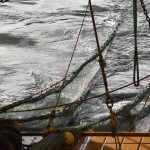The season for shrimp-baiting starts this week but on the right tide and in the right location, a good shrimp-baiter can fill a 48-quart cooler in an hour or less. However, Vincent Flowers, a commercial shrimper based on Edisto Island north of St. Helena Sound, said the cost of shrimp baiting in today’s economy keeps many off the water and the 60-day season no longer poses the threat to his business it once did.
As per Flowers statement way back in 1988 it used to affect them a good bit because the shrimp wouldn’t move, they wouldn’t move up the creek like they’re supposed to. That’s because the shrimp were attracted by all the bait — usually fish meal mixed with clay and rolled into softball-sized lumps — that remained in the water long after the shrimpers who put it there returned to the landing.
Flowers said that hasn’t happened in recent years because of the reduction in the number of shrimp-baiters. According to the S.C. Department of Natural Resources, license sales for shrimp baiting peaked at 17,497 in 1998 and have steadily declined since, totaling just 8,262 last year.
S.C. Seafood Alliance director Frank Blum said shrimp-baiters can create problems if they sell their catch, which is illegal. And baiters don’t always adhere to the daily limits of 48 quarts of shrimp per boat, or 29 quarts of shrimp with heads removed, he said. DNR release also states that the stable catch-per-trip suggests that shrimp abundance has remained relatively good, but fewer licenses and shrimping trips are resulting in a lower overall harvest.
Craig Reaves, president of the S.C. Shrimpers Association and owner of Sea Eagle Market in Beaufort, said he enjoys seeing recreational shrimpers have a good time on the water. Occasionally, some of them stop by his shop to buy shrimp if they have no luck.








